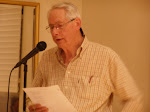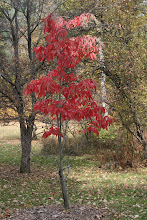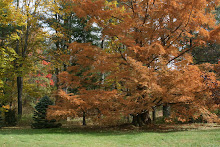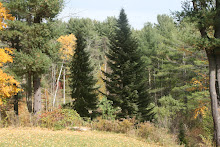
In 1941 Gan Duo, a botanist, came upon a village in west-central China. The villagers there had a small shrine at the base of a large tree of a then unknown species. The villagers worshiped a god they believed lived inside the tree. So was found the first and at the time only live example of a tree known then through its fossil record, the metasequoia (metasequoia glyptoboides) Seeds were collected on later expeditions and a large grove discovered deep in an isolated valley. The native trees are rare. Only a small population was ever known. Found on the Sichuan-Hubei border country, the center of population for the metasequoia was about 6,000 large trees and most of them were logged in the early 1950s. According to The Gymnosperm Database the conservation status of native metasequoia is critically endangered. The tree is known as a fossil or relic tree. One that had world wide distribution 100 million years ago. A common name for it is "Dinosaur Tree" It is thought that the third ice age, 3 million years ago almost drove the tree to extinction. Today the metasequoia is widely planted as an ornamental, especially prized because of its "rapid growth". It is reported that several million trees (most from root cuttings) are planted in China each year. The tree has been introduced in over fifty countries. Other common names for the metasequoia are "Dawn Redwood" and "Water Fir" (SHUI SHANC in Chinese).

John with 2009 metasequoia planting (rust colored)
Experts describe a tree with "a tapering trunk broadening to the buttressed base, conical when young, developing a broad, rounded crown with age." How old the trees live to is not known. The age of over 400 years is attributed to the old tree first found in the village in China. As Pine Hollow Arboretum's John Abbuhl asked "Does anyone know of any who stopped growing and succumbed to old age?"
Not every tree species is going to have equal success at an arboretum and we are lucky here at Pine Hollow Arboretum to have conditions that nurture the metasequoia. The Metasequoia Field is a favorite stopping place for visitors and the trees themselves are attractive for many of the children that visit with their parents or with school groups. Their native habitats in China are shady, moist sites, such as ravine stream banks. They like to have their feet wet but not as wet as some other species like the Bald Cypress, a swamp tree that also seems to do well here. John Abbuhl said that like all redwoods, the metasequoia like moist deep soil. He said it seems our soil and water are perfect conditions for them to do well. Another part of the interesting history of the metasequoia is because of Red China's closed to the West policies
the only available trees came from seed brought out of China in 1946 and propagated by the Arnold Arboretum. Our trees come from this genetic stock. As might be expected, western stock suffers from inbreeding depression. Currently Dawes Arboretum has young plantings from new seed stock which can be used to improve the genetic mix at some time in the future. We have six metasequoia growing at Pine Hollow Arboretum. Three were planted in 1968-70 purchased from Jeffer's Nursery in Slingerlands, New York. Another was planted some time later in the early 1980's with one failure because of mouse griddling the first winter. Last year and this year new young trees were planted. The tallest (but not the oldest) tree is about sixty feet tall. The original tree has the largest trunk, about five feet around. This tree is producing cones but as of yet no seedlings. Of the oldest three trees, the third has started a growth spurt. John Abbuhl thinks it was perhaps in too wet of a spot but now as its root system has spread it is reaching more optimal balance of soil and water. The largest know metasequoias are about 160 feet tall with a trunk diameter greater than 8 feet. Those are in China, of course. In North America, the Pine Hollow Arboretum trees are very respectable, among the larger sized. There are numbers of older trees but not all of them are in such perfect settings.
--- Alan Casline












